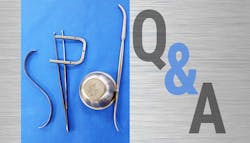Transporting soiled and sterile items separately; testing all levels of washer disinfectors
Submit your questions: email: [email protected]
Q
I am the infection control coordinator of an ambulatory surgery center. We have eight procedure rooms. All of our rooms are in line along a corridor, and at the end of the corridor is our instrument reprocessing/sterilization area and sterile supply room. Sterile sets and supplies are delivered to the surgical procedure rooms on open, three-tier, stainless steel carts. At the end of a surgical procedure, soiled instruments are placed back in an instrument basket with a moist towel over them, put in a clear plastic bag and then placed back on the cart. Any unused instruments or sterile packages are placed in an open plastic bin on the same cart. They are then transported up the corridor to the reprocessing area.
We recently were inspected and received a negative rating for the way we were handling and transporting soiled and sterile items. We only have the one corridor from the OR, and it is a very short trip, nonetheless the inspector said our practice is unacceptable and we must come up with a better protocol. We really do not have the space to provide separate carts for used and unused items. Do you think our practice is unacceptable considering our constraints? If not, what would you suggest?
A
Your current practice for transporting contaminated items is in violation of OSHA regulations, as well as professional guidelines and standards, such as AAMI and AORN. It is essential that at all times there is complete segregation between clean, soiled, and sterile items. Soiled instruments should be transported in a closed containment device, which is clearly identifiable, either by labeling or other means, as containing soiled biohazardous items. Soiled instruments need to be in a rigid, puncture-resistant, closed container. The soiled instruments could easily tear or puncture a plastic bag, becoming a potential source of cross-contamination and possible cause of injury to staff.
The fact that you are transporting your items a very short distance does not negate the need to comply with standards and regulations. There are several options of closed carts suitable for transporting and containing soiled items from the OR to the reprocessing areas. I understand your space constraints and would recommend that you consider a two-compartment cart, with which one compartment is exclusively for clean and/or sterile items, while the other segregated compartment is used to hold soiled items. The carts are available in many different sizes with the ability to hold between four to twenty containers. A tall cart design takes up less floor space and would work very well in your situation. (See figure 1.)
Q
I am the OR materials manager. We have four instrument washers in our reprocessing room. Each machine has three shelves in it. Recently, the new lead surgical tech has begun running daily washer tests on every machine and shelf. We have been using 60 tests a week, which is very costly. If we were to continue this high usage, it would increase expenditures to well over $9,000 annually.
I proposed that we test one shelf of one machine per day and do a different washer each day. That way we would be doing daily testing as guidelines recommend and each machine would be tested weekly. We can’t afford to continue this excessive testing and my proposal will reduce the costs by 90 percent. I am getting some resistance to change from the lead tech and some staff members. Do you see any disadvantage to my proposal?
A
AAMI ST79 standards state that mechanical cleaning equipment performance should be tested each day the equipment is utilized and that the test results should be recorded. To adequately test a multi-level washer disinfector, you really need to test each level. Each level of a washer relies on separate spinner arms to deliver water, cleaning agents and mechanical action, e.g. impingement. The impingement, or force of spray from the spinner arms, is necessary to dislodge and or remove soil from the items being cleaned. The spinner arms of each level work independently of each other. Any one spinner arm could malfunction or get clogged and not deliver the water, detergent and required mechanical action to the level of the washer they service. It therefore is possible to have any one level of a washer fail to effectively clean the items on that level.
Without testing every level of a washer, you will have no assurance that washer is functioning properly. Improperly cleaned instruments and medical devices can provide a conduit to disease transmission, presenting a risk to patients’ and healthcare workers’ safety and welfare.
You asked if I see any disadvantage to your proposal: Yes, I believe that your proposal is extremely dangerous, and that you should rescind it immediately. You also stated that you could not afford to do this “excessive testing.” I would hope that after reading my response, you’ll agree that the daily testing is not excessive, rather it is the correct way to confirm the proper performance of a mechanical washer. In my opinion, you cannot afford not to perform your washer testing properly.
